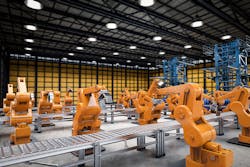Differences Between Field, Control, Supervisory, and Enterprise Levels of Automation
Automation takes mechanization one step further. While mechanization replaces manual labor with machines, automation replaces human guidance with controls hardware, computers, and programming (PCs, PLCs, and PACs, for example), together with some help from communication devices and hardware.
But automation systems can be complex, with a large number of devices working in synchronization. To make it easier to talk about automation, especially when done in a factory setting (industrial automation), engineers and plant managers have divided the topic up into three categories: field-level automation, control-level automation, and enterprise or information-level automation. Here are short explanations of each:
Field Level
It is the lowest level of the automation hierarchy and consists of field devices such as sensors and actuators. Sensors, the eyes and ears of automation, collect data on temperature, pressure, speeds, feeds, and so on, convert it to electrical signals, and relay it up to the next level. The main task of these field devices is to transfer data on processes and machines for monitoring and analysis.
It also includes the actuators, which are controlled by the next level through electrical or pneumatic signals, converting them into actions. Actuators are similar to the body’s muscles, which are the only way humans can interact with their environments. Actuators turn valves, relays, motors, pumps, and other devices on or off, or adjust their outputs to control the processes.
Control Level
This level consists of various automation controllers such as CNC machines that gather process parameters from various sensors. The automatic controllers then drive the actuators based on the processed sensor signals and the program or control technique.
Programmable logic controllers (PLCs) are the most widely used and durable industrial controllers that can deliver automatic control functions based on sensor inputs. They consist of various modules such as the CPU, analog and digital I/Os, and communication modules. It lets technicians program control functions or strategies that carry out certain automatic operation on process.
Supervisory Level
In this level, automatic devices and monitoring systems facilitate the control and adjustment functions. These include Human Machine Interfaces (HMI), Distribution Control Systems (DCS), and supervisory control and data acquisition (SCADA) devices for monitoring various parameters, setting production targets, historical archiving, and setting machine start and shutdown.
Enterprise Level
This top level of industrial automation, which is also called Information-level automation, manages the whole automation system. The level handles production planning, customer and market analysis, and orders and sales. So it deals more with commercial activities and less with technical aspects.
Industrial communication networks tie all these levels together, sending data from one level to the other. These communication networks can be different form level to level. These networks include RS485, CAN, DeviceNet, Foundation Field bus, and Profibus.
With this hierarchy in place, there is a continuous flow of information from high level to low level and vice-versa. As data goes up, information gets aggregated, and as data goes down, it provides detailed information about the process.
Types of Industrial Automation Systems
There are three general types of automation systems:
Fixed or Hard Automation performs fixed and repetitive operations to achieve high production rates. It uses special-purpose or dedicated equipment to automate a fixed sequence of assembling and processing operations. Once put in place, it is relatively hard to change or vary the what the system builds or creates. Therefore, while it is inflexible in providing product variety, it increases the efficiency with higher production rate and reduces unit cost.
Programmable Automation consists of assembling and processing operations that can be changed by modifying the overall control program in the automated equipment. It is best suited for a batch production process where product volume is medium to high. It is still difficult to change and reconfigure the system for a new product or sequence of operations. Therefore, new products or reconfiguring the sequence of operations requires a long setup.
Flexible or Soft Automation systems provide the automatic control equipment with the flexibility to change the product design. These changes can be performed quickly through the commands given in the form of codes to various machines by technicians. It lets manufacturers turn out several products on the same production line. Some examples of this type of automation equipment include automatic guided vehicles and multipurpose CNC machines.
Benefits of Automation
There are five basic reasons for automating a process or an entire assembly/production line:
To increase productivity. Automating a factory or manufacturing process speeds production by better controlling it, which can significantly slash assembly time per product. Therefore, for a given labor input, automation generates more output.
To lower operational costs. Integrating various industrial processes with automated machineries minimizes cycle times and effort and therefore lowers the need for manual labor. This cuts labor costs. Automated equipment properly used should also cut material costs. of human labor gets reduced. Thus, the investment on employees has been saved with automation.
To improve product quality. Automation removes human involvement from production, so the possibility of human errors should also be eliminated. Uniformity and product quality can be maintained with automation by adaptively controlling and monitoring the industrial processes in all stages from product inception to finished product.
To reduce routine checks. Automation reduces the need to manually check various process parameters. Industrial processes can automatically adjust process variables to set or target values using closed-loop control.
To improve safety. Industrial automation substitutes machinery for personnel in hazardous or risky working conditions. Traditionally, industrial robots and robotic devices serve in these environments.

